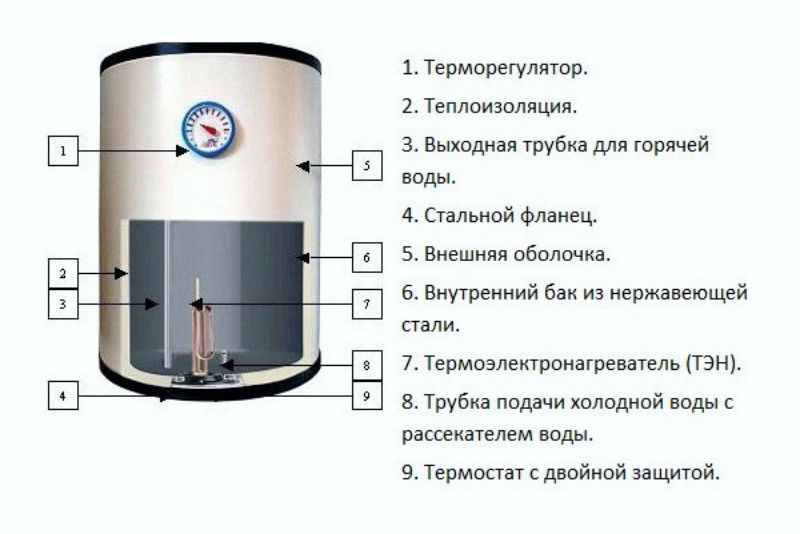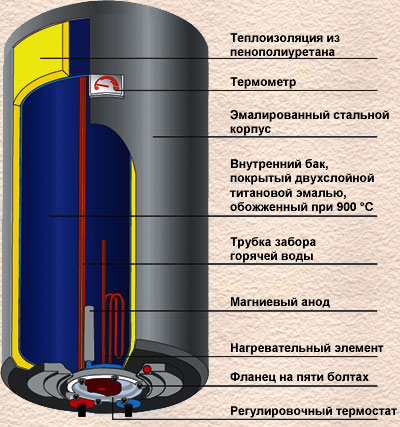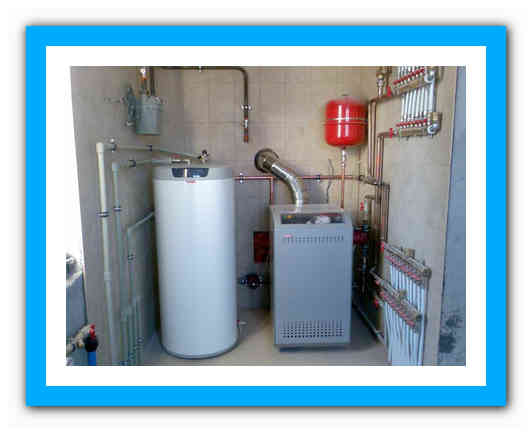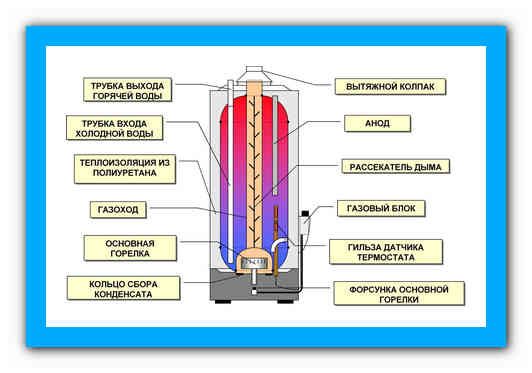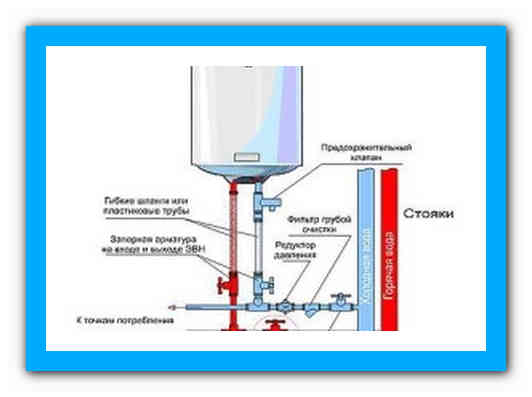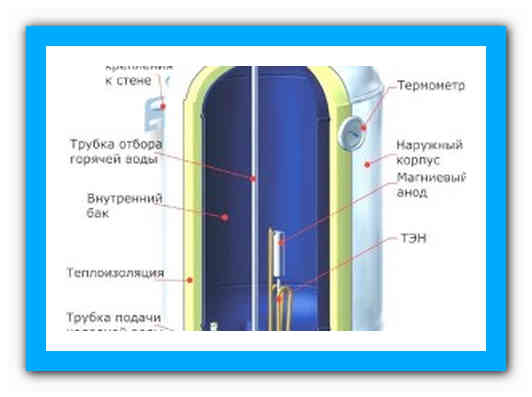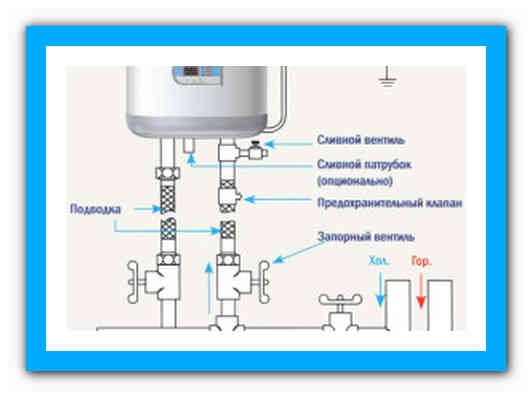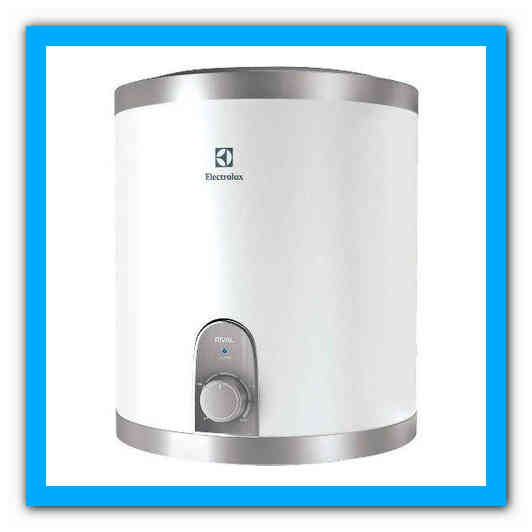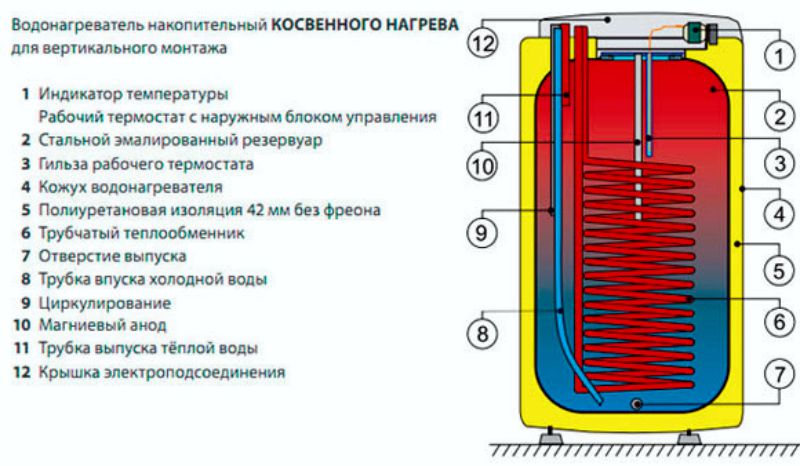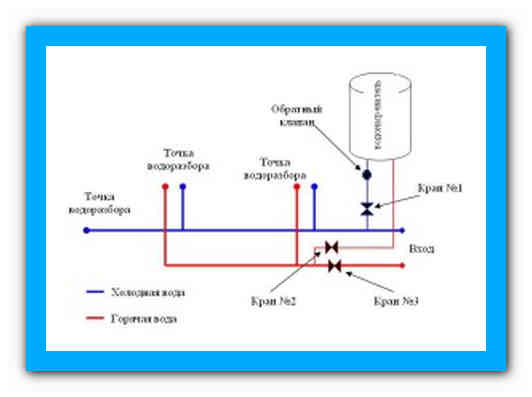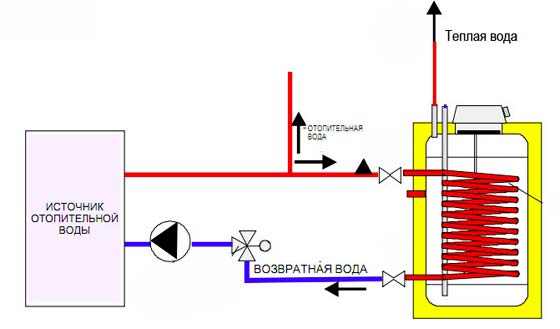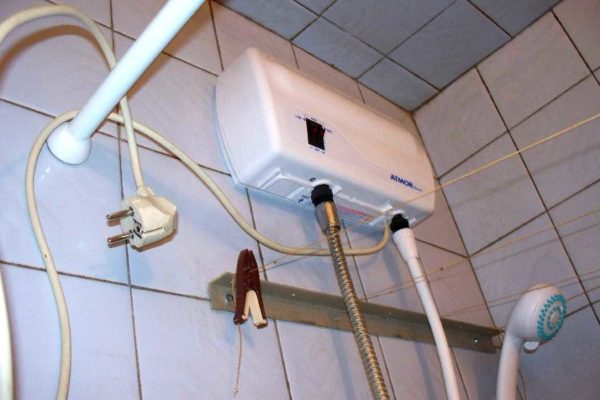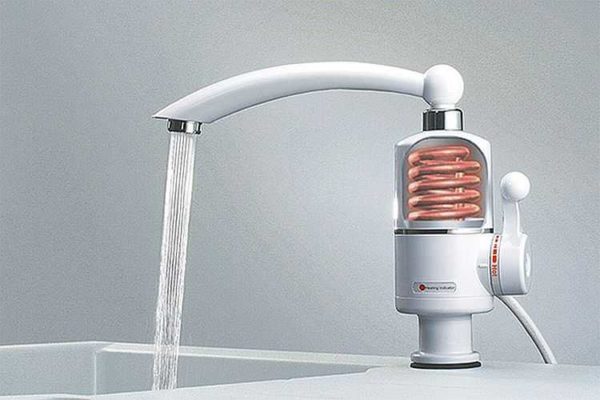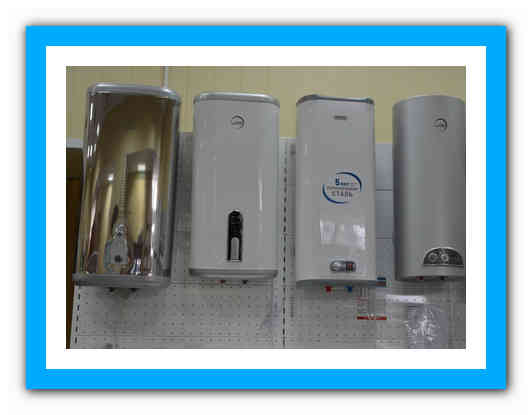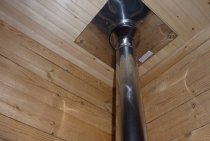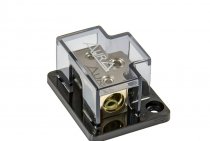The main elements of the boiler
Many people who want to buy a water heater for themselves are wondering how the boiler works. The answer to this question is provided below.
So, the design of a water heater installed in houses and apartments includes the following elements:
- frame;
- insulating layer (responsible for ensuring that the liquid cools as slowly as possible);
- water tank (it is heated in it);
- TEK - a mechanism for heating water (according to the principle of operation, similar to a boiler);
- anode - an element on which all scale remains;
- inlet pipe (it is connected to cold water);
- outlet pipe (connected to a faucet from which hot water flows);
- safety and temperature control sensors;
- control panel, which includes control knobs and a display (not available in older models of boilers).
Due to the fact that the formation of various kinds of microorganisms and mucus can occur inside the water tank, it is recommended to select a model where this tank is made of stainless steel or titanium is sprayed.
For those who cannot afford a water heater in which the tank has the above coatings, you can take a boiler where the tank is made of glass porcelain. But the shelf life of this material varies from 1 year to 3 years, since it is covered with microcracks very quickly.
Boiler design
In this diagram you can see the main elements of the boiler design.
A boiler is a device that heats and stores hot water. Structurally, it is a container of one or another volume, equipped with thermal insulation and a heating element. The water supplied to the tank is heated to a predetermined temperature, after which it can be used by consumers. Adjustment and maintenance of the heating temperature are carried out using the built-in thermostat. The maximum temperature reaches + 70-80 degrees.
Most boilers are pressurized. That is, the water at the outlet flows under the same pressure as it is supplied to the tank of the unit. If the supply of cold water stops, then it will not work to get water from the storage water heater - it simply will not flow out of it. Thus, the water in the tank is under constant pressure (increasing when heated).
How is the boiler arranged and what nodes can we find in its interior?
- A tank with a protective coating is the basis of any storage water heater. Tanks are made of metal and coated with enamel or glass-ceramic to prevent corrosion. The capacity of the tanks varies from 10 to 300 liters;
- Heating elements - inside the boilers we can find one or two heating elements. They are responsible for heating the water (in gas boilers, this function is performed by the burner);
- Thermostat - provides support for the set temperature (mechanical or electronic adjustment is used);
- Control panel - hidden or open, with its help temperature setting is provided;
- Thermometer - provides control of the temperature of the water in the tank. The thermometer can be mechanical or electronic.
The design of the boilers is extremely simple, and the main volume is occupied by massive tanks of various capacities.
Varieties
Today, a very large selection of electric water heaters of various types and types with a different price range is presented on the domestic market of Russia, while the build quality and individual parts can vary greatly. The electric instantaneous water heater has long enjoyed well-deserved popularity among users from different regions of the Russian Federation due to its simple operation. They are divided into two main types:
- pressure or closed type;
- non-pressure - open type.
The first option is able to supply several points with hot water at once: a washbasin, a shower cabin, a kitchen, but for this it is necessary to ensure a fairly high pressure in the home water supply line.
The second option functions normally at any pressure in the line with a direct connection to the water intake point.
Boiler device for heating water, depending on the type
Such devices are of electric and gas type. As for the design features, the product consists of a tank into which water is drawn, as well as thermal insulation and an external case on which a control panel is installed.
Installed inside:
- Heating element or, in other words, heating element;
- Special magnesium anode;
- thermostat;
- Special pipes.
A water heater with indirect heating is installed in an apartment building or a private cottage, which has independent water heating, with permission to install a single-circuit boiler. The increase in temperature inside the indirect heating tank does not occur through an impact on the energy source, but as a result of heat exchange with the heating circuits.
The device has its own heat exchanger in the form of a coil.
It is located along the entire length of the tank or can be located in its lower part. Each of the two pipes of the heat exchanger is connected to a heating boiler. The heat carrier installed in the boiler moves through the heat exchanger, and due to this, the water in the tank is heated (due to a process such as heat transfer).
Removal is carried out through a special pipe that directs water into the boiler. As a rule, the heat exchanger is installed alone, but there are models in which there are several heat exchangers. In this case, it is permissible to connect the equipment to a gas boiler and similar sources.
An indirectly heated boiler can be without a coil, such designs are called "tank in a tank". In other words, another tank is installed inside the tank. Heating of water suitable for operation takes place in a tank, which is located in the very center of the product.
Combined models are a combination of two previous models in one. They come with indirect heating, however, they have a heating element installed in the tank cavity, through which you can use the product as a storage electric boiler.
Furnace or boiler room what is it
It is easy to guess that a boiler room is a place where a boiler is installed to heat water. There are special requirements for this room. Finishing must be of non-combustible material. There must be excellent ventilation. Heating radiators are installed in the boiler room. Devices are connected only according to the rules so that safety is observed in all respects.
A water electric boiler is sold in a large assortment and it is possible to purchase different equipment, choosing according to such parameters as:
- Dimensions;
- Power;
- tank capacity;
- Location type.
Electric types of heaters differ from gas ones. He, and inside is arranged differently, and works differently from gas. To be more precise, it has a different structure of the heating element, and this is a heating element.
Only he is responsible for how quickly a certain amount of water can be heated and to what temperature.
Tens are dry and wet. Dry ones are placed in an additional capsule, and heating with such an element takes much longer. Near the heating element, a special temperature sensor must be installed, due to which the operation of an electromechanical or electronic thermostat is controlled. Thus, the maintenance of the water temperature at a given level is ensured. When the liquid cools, the temperature sensor is activated, and the automatic heating of the contents of the tank begins.
Simple design of a gas boiler
The boiler is controlled by a temperature sensor and a thermostat. They are responsible for fixing a certain level of water temperature, and as soon as the heating reaches the desired level, the system automatically turns off. Gas boilers are equipped with a safety group or, in other words, a special safety valve that releases too high pressure. Thus, explosion of the product and the like are prevented. To prevent the formation of scale on the product, a magnesium anode is also installed in it, which must be changed over time, since it is destroyed due to the action of salts in hard water.
Boilers can be of various types, types, shapes and even installation methods, but the requirements for their purchase are on average the same, as needed:
Inspect the body for integrity;
Pay attention to the availability of certificates for compliance with GOST;
Buy products only at specialized points of sale;
Be sure to check the terms of the warranty.
Do-it-yourself water heater installation
Scheme of the device of the connected water heater.
Instantaneous water heaters are much easier to install with your own hands than storage water heaters. To do this, you just need to install a special machine and lay a powerful three-core cable directly from the switchboard. Installation is carried out in 2 versions:
let the cable under the plinth or gouge the wall, after laying the cable, seal it with cement or putty.
From the tool you may need:
- perforator;
- screwdriver;
- drill;
- spanners;
- pliers.
Do-it-yourself installation of a storage-type water heater can take from 2 to several hours. First you need to calculate exactly how much tank you need. This must be done in order to understand exactly how the water heater should be mounted.
So, tanks with a volume of up to 100 liters can be hung on the wall, but with a volume of more than 150 liters they must be placed on the floor.
According to the rules, a storage-type water heater tank should be located at least 30 cm above the floor. The most convenient attachment point in the apartment is above the toilet in the toilet.
Scheme of the device of the water heater.
Everyone chooses a specific height for himself, based on his height and the height of his family members. Installation of such a water heater may require several people (at least 2).
The tanks go on sale together with the necessary fasteners: anchor bolts - 2 or 4, depending on the type of water heater.
- Therefore, when installing with your own hands, the anchors must first be attached to the wall according to the instructions. The required distance, if not specified, is calculated from the notch on the back of the tank.
- The main thing to remember when installing a storage-type water heater with your own hands is that the wall must be load-bearing. If the wall crumbles when drilling, you need to take longer anchors.
- When the tank is not securely fixed, there is a high probability of its collapse. Who wants to change the toilet with their own hands? So the installation should begin with checking the complete set of storage water heater.
Scheme of connecting the cold water line to the water heater.
There are 2 special outputs on storage water heaters: red and blue. This is for cold and hot water, respectively. The safety valve included in the kit is attached to the blue hole. It is necessary for the correct operation of the water heater: this valve is responsible for relieving excess pressure in the tank.
2 special ball shut-off valves are attached to the red outlet from the tank and to the check valve of the blue outlet. The tank can be attached to water pipes and a mixer using metal-plastic pipes or using a flexible connection of the required length.
If during installation with your own hands you decide to stay on metal-plastic pipes, you should remember 2 mandatory things:
- it is impossible to bend such pipes;
- pipes must be carefully selected. So, seam metal-plastic pipes are suitable only for cold water, while hot pipes require seamless pipes.
- If it is planned to install and use a flow heater in the apartment, then, as noted above, it will require a three-core cable.
- A gas instantaneous water heater is not yet the most common occurrence in a modern apartment. And since you will have to deal with the gas main, it is better to invite a specialist for the correct installation and connection of the gas device.
Whichever option you choose, the main thing will be the uninterrupted availability of hot water, which will undoubtedly greatly facilitate the life of any person.
We study the device of the boiler: 4 internal elements.
Boiler design for heating water
The design of the boiler includes elements for heating water, which are divided into the following types:
- Located in water (they are called open or wet).
- Elements that do not have direct contact with water (they are called closed or dry).
Wet water heating elements are quite familiar to us and resemble tubes placed in a kettle. They are hollow and contain a heating coil. Empty space, as a rule, is filled with special magnesium oxide or sand. The substance can be anything, the main thing is that it has a high conductivity of heat.
Dry water heating elements are separated from contact with water by a special ceramic casing.
This type is considered safer due to the following points:
- no scale formation occurs;
- the risk of a short circuit is practically zero;
- accidentally turning on the device without liquid does not spoil this type of heating elements so much;
- service life is much longer.
In addition, these elements differ depending on the type of fastening, they are nut and flange. In the second case, a large number of small bolts are pressed.
Storage water heaters
Scheme of installation of a water heater.
Often they are arranged in the form of a tank filled with water. Water is poured into it, after which it is heated to a predetermined temperature.
Such heaters are equipped with a special air gap that prevents the water in the tank from cooling down quickly. So, by heating the water in the morning, you can use it throughout the day or until it runs out. Devices must be connected to the network at all times.
Due to the operation of the thermostat, the water in the tank always remains heated to a certain value: when the water cools to a certain temperature, the heating element turns on.
The boiler of this device is mounted mainly either in the bathroom or in the toilet. Storage water heaters are attractive because they consume little electricity. However, you will have to puzzle over where to place the volumetric tank, and wait at least 1-1.5 hours until the water in the tank is heated.
What is an indirect heating boiler
Indirect heating boilers use heat from the heating system of the house to heat water.
A little higher, we considered the design of an electric water heater. Now we will talk about indirect heating boilers. What are they and how do they differ from electric models? Indirect heating boilers operate from heating systems, taking part of the heat from them. Inside them are coils, characterized by a large area - they provide rapid heating of water. There are also thermostats and thermometers.
Indirect heating boilers are characterized by high efficiency and productivity, since the area of the heating elements (coils) is quite large, and heating is carried out throughout the volume.How to get hot water in the warm season, when the heating systems are no longer working? To do this, you need to purchase or make an indirect heating boiler with a built-in heating element - it will provide water heating when the heat from the heating system is not enough.
Domestic indirect heating boilers are highly economical, since in the winter season they do not consume electricity, but are powered by heating systems. At the same time, their connection to heating does not lead to a noticeable gas consumption, which is a big plus.
Some characteristics
So, before you start installing water heaters with your own hands, you need to figure out which one is right for you in terms of all its characteristics.
To date, there are several types of water heaters on the market:
- accumulative;
- electrical flow;
- flowing gas type.
Of these, each buyer chooses solely according to his preferences. As a rule, a big role is played by how often and how many people will use this or that water heater during the hot water shutdown period.
If one person and not very often, then you can put yourself a flow element. But if at this time 3 or more family members live in the apartment, then the storage accessory will be the best choice.
Principle of operation
How does an instantaneous water heater work? A stream of water passes through a product of relatively small size, heating it to the desired temperature. The heating element is used as a standard type or as a heating coil. In volumetric devices, the first option is always used, and in miniature devices, the second one, because the heating element simply has nowhere to insert it.
As soon as the tap opens, the heating element turns on, the water flow heats up, and when the tap is closed, the power supply to the product is also turned off. The principle of operation of an instantaneous water heater is based on the fact that the temperature of the water flow set by the user is gained in a short time, and then only with the help of a heating element it is kept constant. Externally, an ordinary flow-through electric water heater looks like a small plastic container that has a connection to a home water supply.
When a flowing electric water heater is used as a separate tap for hot water, its principle of operation becomes even simpler: the water flow is instantly heated by a powerful spiral enclosed in a copper casing.
Features of the video boiler device
Having studied the above, you can be sure that the equipment is in good working order and will last a long time, without bringing problems, and even more consequences in the form of an explosion of pipes and a tank, which can cause the destruction of the whole room and entail far from small expenses.
4 questions about the placement of a water heater in the interior.
The choice of location for a water heater in the house depends on the need for hot water, the layout and size of the room. This is a responsible matter that requires an engineering approach and correct calculation.
1 Floor or wall? If the volume of the storage water heater exceeds 200 liters, it is better to consider the floor option. In such tanks, thicker steel is used and a copper heating element is installed that is not subject to corrosion. Floor heaters, as a rule, are used in country houses, where both needs and opportunities (at least in terms of accommodation) are higher than in a city apartment. Small wall-mounted water heaters with a volume of 50-80 liters are usually installed in apartments to compensate for hot water cuts.
Horizontal or vertical? There is an opinion that in horizontal water heaters, water warms up worse: due to convection, it is warmer at the top than at the bottom. However, experts reassure - we are talking about fractions of a degree.But the horizontal model can be built in small rooms where it is not possible to place a vertical water heater, and almost anywhere - for example, hang over a doorway. Some manufacturers produce universal water heaters that can be hung both vertically and horizontally. The heating element in such systems is located at an angle, so that the water will evenly warm up in any case.
3 Why is a flat water heater convenient? Another solution to the problem of lack of space is to choose a flat-plate water heater, which takes up less space than conventional storage units and looks sleeker. Alas, energy efficiency is often sacrificed for aesthetics: the size of the tank can be reduced due to the heat-insulating layer. To understand whether the tank is sufficiently insulated, put your hand on the case - if it is warm, then the thermal insulation cannot cope, if it is cold, everything is in order. Good thermal insulation cannot be less than 40 mm thick, and better - from 60 mm.
4 Where to install the water heater? General rule: the distance from the hull to the points of disassembly (cranes) should be kept to a minimum. Firstly, it reduces heat loss, and secondly, you will have to wait less for hot water. In a city apartment, a water heater is usually installed in the same room where the analysis takes place: in the bathroom or in the kitchen. Another thing is a big house. In this case, the system should be designed by a specialist who will find a place taking into account the layout, calculate the length of the pipes and the required volume of the tank. If water heating is not "tied" to the operation of boiler equipment, it may be advisable to place the heater in the attic. If the house has boiler rooms, where all communications are located, it is also convenient to install a water heater there. It will be out of sight, but at the same time available for prevention and repair.
Understanding how an electric boiler works
The tank capacity is surrounded by a heat-insulating layer, on which a decorative plastic or metal case is installed. The flow of cold water is carried out through a special pipe installed at the bottom of the device. When using hot water, that is, when the tank capacity is empty, the cold liquid is automatically drawn in and gradually heated.
In other words, hot water is always present in the tank, provided that the device is connected to the network.
As a rule, the scheme of operation of such a device can be supplemented with an element such as a magnesium anode. It is he who helps to extend the life of the heating element, since when in contact with hard water, salts are attracted. The result is that the scale is formed on the anode, and not on the heating element, this can be seen in the section. Replacing the anode is much easier and much cheaper.
Gas boilers are installed less often than electric and storage boilers, they are cheaper than analogues, not the safest devices for heating water, and besides, they are produced in limited quantities, and there are many difficulties in installing them.
Namely, if there is a need to install the product in an apartment building, then it is required:
- Coordination with neighbors;
- Installation of a chimney;
- Excellent ventilation;
- Instrument registration.
The devices can operate on natural gas. The design consists of a water tank, an inlet pipe with a cold water supply, a branch pipe for the hot water outlet. The body of the product is thick and there is additional space between it and the water tank, due to which the water inside is stored for a long time.
The heat exchange process is carried out through the lower wall, since it is there that the combustion chamber and the gas burner are located. Heat can be transferred through the inside of the tank from the central channel, through which the combustion product generated in the combustion chamber flows into the chimney.
